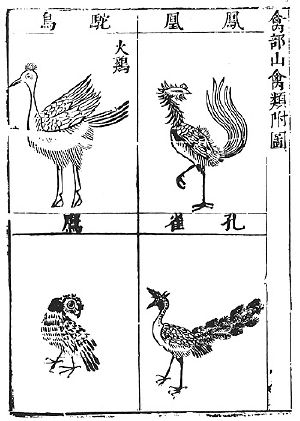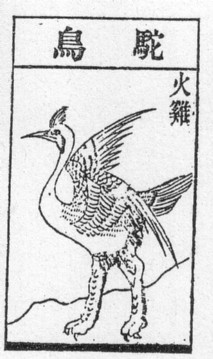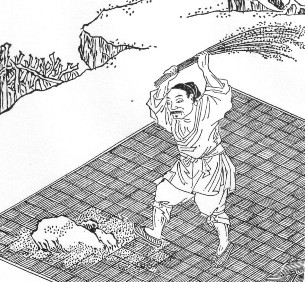
To next Page
Li Shih-chen: Pen ts'ao kang mu (The Great Herbal).
---------------------------------------------------
Taken from: Chinese Medicinal Herbs: A Modern Edition of a Classic Sixteenth-
Century Manual.
Compendium of Materia Medica (Bencao Gangmu) Li Shizhen
And many other books.
The book got actually compiled in 1578 out of a whole range of medieval books. In his book Li Shen-chen mentions where he got the information. This book is a great source to find out what the Chinese did with the imports they brought from Africa.
Tuoniao (Ostrich)
.................
In the book Xingcha Shenglan by Fei Xin: In countries like Zhubu-guo and Adan-guo, (A-den and Dju-bo on the East African coast) there is a kind of bird called Tuotiji (meaning chicken with camel feet). It is six to seven chi tall. Its feet look like those of a camel.
...............
Tuoniaoshi: Faeces of ostrich. It is nontoxic.
Chen Cangqi says: it is good for treating a case where a person swallows iron or stone by accident. Take the remedy. This will dissolve the object.
Longxian; Dragon saliva (Ambergris)
......................
Wang Ji says: Dragons spit out saliva. It can be used to make incense. Li Shizhen says: Dragon saliva is seldom used by doctors. It can be used as an ingredient in making incense. It keeps the aroma of Longnao/borneolum syntheticum/borneol and Shexiang/moschus/musk potent for several dozen years. Some say that when dragon saliva is burned it emits a kind of smoke which stays in the air. It is found in the sea in the southwest. People say this is saliva spat out by dragons in the spring. It gathers together and keeps afloat. Local people collect it and sell each liang for 1000 coins. There is also another substance that is obtained from fishes abdomens. It looks like glue and fat of yellow and white color. When dried, it turns yellow and black. It looks like Baiyaojian/massa fermentata gallae et thei/leaven of Chinese nut-gall and tea. But it is finer in its texture. After long storage, it turns purple and black. It looks like Wulingzhi/faeces trogopterori/trogopterus dung. But it is lustrous. It is light and looks like Haifushi/ffumex/pumice. But it smells fishy and foul.
Luhui (Aloes)
...................
It is bitter, cold and nontoxic
It is good for treating restlessness and suffocation due to invading pathogenic Wind and Heat. It disperses heat resting in chest and diaphragm, brightens the eye and relieves palpitation. It also treats infantile convulsion and epilepsy, and five kinds of infantile malnutrition. It kills three worms, treats haemorrhoid, sore and fistula, and detoxifies toxin of Badou/ fructus crotonis/croton seed.
Myriad Harmonies Pills; Wan-ying-tan. Humau urine sediment, spirit leaven, white grapes, withered carrot root, lign aloes, and honey. Used for jaundice and all bilious difficulties.
A bitter crystalline extract (of aloes) called �elephant gall� because of its taste, was given to small children for anaemia with fevers. It was said to grow in Persia.
Moyao (Myrrh)
...................
Ma Zhi says: Moyao is produced in Persia. The drug may be big or small with an indefinite shape. It looks like Anxixiang/benzoinum/benzoin.
Su Song says: Now it is also produced in Hainan and Guangzhou. The trunk and root of the tree look like a white canary tree. It has green and flourishing leaves. From an old tree, a kind of resin will flow and drop onto the ground to form big or small pieces. It looks like Anxixiang. There is no definite time for collection.
................. Su Piao says: The myrrh grows in the country of Po-se, and is the pine tree resin of that locality. In appearance it is like sen hian (divine incense) and red-black in color. As to its taste, it is bitter and warm. Li Si-cen says that he is ignorant of what the product sen hian is.
It removes blood stasis and relieves pain. It is used to treat incised wound and scores due to flogging. It also treats various malignant sores, haemorrhoid and fistula. It stops sudden hematochezia, and treats nebula and opacity in the eye with inflammation and pain.
Nine fairies life-saving pills; Chiu-hsien-t�ao-ming-tan. Cinnabar, flower of sulphur, olibanum, myrrh, Baroos camphor, dragon�s blood, sulphate of copper, copperas, musk, burnt alum, bear�s, gall, yellow lead, centipedes, earth worms, silk worms, plum flowers, cow bezoar, toad spittle, white jade dust, borax, tree grubs, and snails. For the treatment of all sorts of infected sores and boils.
Protecting pregnancy pills; Pao-t�ai-wan. Pachyma cocos, Atractylis ovata, Hibiscus rosa sinensis, myrrh, Cyperus rotundus, coriander, Leonurus sibiricus, and honey. These are to prevent threatened abortion and to render labor easy.
Amber powder; Hu-p�o-san. It is made as follows: Take of amber, one ounce; Corydalis ambigua, one half ounce; myrrh, one half ounce; rhubarb, one fourth ounce. These are to be all heated together and beaten into a powder. The drug is considered to be styptic and tonic, and it is used after labor with a view to restoring the normal circulation of the blood, in which case the rhubarb is left out.
Cinnabar five odor pills; Ch�en-sha-wu-hsiang-wan. These are made of cinnabar from Chenchou in Hunan, dragon�s blood, olibanum,, myrrh, Corydalis ambigua, Huachou orange flowers, and honey. They are carminative, anti-spasmodic, and anti-emetic.
Qilinjie; Dragon�s blood
...................
Li Shizhen says: Qilin is also a name of a kind of horse (a giraffe actually). As this drug looks loke dry blood, it is called Xuejie (exhausted blood).
...............
The book Yitong Zhi says: ..........It is produced in western countries like Dashi. There is a way of testing its authenticity: if thee drug can penetrate into the nail, it is a genuine one............
It is good for treating sudden onset of epigastric and abdominal pain. It stops bleeding in an incised wound, dissolves blood stasis, relieves pain and helps germination of new flesh. It disperses invading pathogenic factors in the five Vicera.
Seven Candarin Powder; (Ch�I-li-san). Use dragon bone, borax, dragon�s blood, catechu, Cannabis indica, and Forsythia suspensa, of each equal parts; powder finely. The dose is seven candarins, and is used in the treatment of wounds as an anodyne.
Seven precious powder; (Ch�i-pao-san). Use dragon bone, elephant�s skin, dragon�s blood, ginseng, Gynura
Xiang; Elephant
.......................
The book Nanyue Zhi says; When the elephant hears thunder, designs appears on its tusk. This disappears after a while. It was said in ancient times that when a rhinoceros looks at the moon, designs grow on its horn. An elephant will have designs on its tusk when it hears thunder.
...................
Zhen Quan says: People in the western regions cherish its tusks and use the ivory to make ornaments for beds and chairs. In China ivory is cherished and is used to make Hu (an official tablet). An elephant will remove its tusks and bury them in the earth right afterwards. People in countries like Kunlun use a wooden tusk to replace the real ivory before taking it away.
.............
Xiangya (Ivory)
The book Zhenla fengtu Ji says: The ivory taken from a just slaughtered elephant is of superior quality. Ivory taken from an elephant dead due to natural causes is secondary in quality. Ivory shed in the mountains long time ago is inferior. Some say an elephant sheds its tusks each year.
(Ivory;) It is sweet, cold and nontoxic.
It is good for treating an invasion of iron objects or other things into the flesh. Scrape bits from the ivory, and blend with water. Apply it on the affected area. This will make the intruding objects come out easily. Scrape bits from the ivory, and stir-fry until golden. Grind into powder. Take the powder with rice soup or hot water to treat epilepsy-from Kaibao Bencao
Stew the remedy in water to make a decoction. Take it to treat dysuria. Burn the remedy into ashes, and administer the ashes to treat incontinence of urine. �from Da Ming Rihua Bencao.
(many more remedies and prescriptions are given)
Xi; (Rhinoceros)
..................
Li Shizhen says: The rhinoceros is found in Xifan (Western foreign countries) and in....
The best way to administer the rhinoceros horn from the Xifan region is to grind the fresh remedy against a stone, and take it directly. If it is going to be used in a medicinal decoction or powder, chop the remedy into scraps and add it to the preparation. ...................
It is good for dispersing invading Wind toxins to the heart involving restlessness, fever and congestion. It stops toxic dysentery accompanied by a bloody discharge, and treats infantile measles, convulsions and epilepsy due to invading wind and heat. �from Haiyao Bencao
Bao (Leopard)
..............
There is also a gold-coin-leopard in the western regions, which has design like gold coins.
Huma (Sesame) (sesame originated in Africa)
..............
It was originally found in the Hu area (north and west of China)...................
Kou Zongshi says: There are varied descriptions of Huma. It is actually just Zhima, and should not be described as other things. As the seed is introduced from Dawan, so it is called Huma. The drug produced in the Hu area has a big fat seed with black white veins. It is purplr-black. When squeezed it emits oil............
Li Si-Cen states: of hu-ma there are two crops (in China), an early and a late one, with black, white or red seeds; all stems are square. (He then criticizes the statements of his predecessors a lot) (Note that Sesame is also a plant of which the original home is in Tropical Africa, there are way earlier notices of hu-ma in China but it is not always clear what plant is really mend.)
Ten-parts Perfect pills; Shih-ch�uen-wan. Musk, Aplotaxis auriculata, dragon�s blood, flowers of sulphur, sesamum seeds, Strychnos nux vomica, maggots, centipedes, and honey. This is for the curing of wounds, of cancerous sores, and as a tonic.
The Tartar General Resumes the Battle Pills; Chiang-chun-fu-chan-tan. Soak wild sesamum seeds in child�s urine for four times and is distilled spirit for three times. Dry and add olibanum, myrrh, and dragon�s blood. This is for wounds and broken bones.
ShuShu (Sorghum) (Sorghum originated in Africa)
....................
Li Shizhen says: Shushu was not very common in the past. But now it is found everywhere in the north. The book Guang Ya: Diliang is merely Muji. This is something in the same category of Shu and Ji. It is as tall as a reed. As it was firsr discovered is Sichuan (Shu), so it is called Shushu
Ku Chin Chu by Ts�ui Pao. In which is stated: Some kinds of ebony, under the name �raven wood� were imported into China by Persian argonies as early as the forth century. The shu shu (sorghum) is fit for poor land. In the spring months the seed is broadcasted In the autumn months it is harvested. The stalks are ten feet or more tall and of a form similar to the lu and ti reeds, but the culms are solid. The leaves are also like those of the lu reeds. The panicles are as large as a broom. The grains are as large as pepper seeds and of dark red color , while the hulled grain is of a hard nature, solid, and yellow and red-colored. There are two kinds. The glutinous variety can be mixed with glutinous rice and glutinous millet and fermented into wine, and may also be used for making cakes. The non-glutinous can be used to make cakes or dumplings and may be boiled into a gruel. It can be used to relieve hunger in time of famine and can be used to relieve hunger in time of famine and can be used to nourish the domestic animals. The tips of the stalks can be used to make brooms; the stalks can be woven into door-screens and matting, plaited into wattles and used as fuel in cooking. It is of the greatest benefit to the people. Those who use this grain in their sacrificial ceremonies in the place of chi are wrong. The grain hulls when steeped in water color it red, and this liquid can be used to redden wine.
Note: Sorghum is a plant of African origin who slowly made its way to China.
Anxixiang (Benzoin)
.................
Li Xun says: It is produced in Persia and Nanhai. It is a kind of resin. It looks like Taojiao/resina persicae/peach resin. Collect the drug in autumn.
Zhang Yuxi: The book Youyang Zazu by Duan Chengshi: The tree of Anxixiang grows in Persia. It is called Bixieshu (tree preventing attacks of vicious agents) It is 20 to 30 chi tall����
It is good for treating sexual dreams in women. Make pills with Xunhuang/realgar/red orpiment. Burn the thing and fumigate the Dantian (the elixir field in the pubic region) This will stop the ailment.
Xiao Bing says: Burn the drug to keep evils and devils away and invite the immortals.
Suhexiang (Storax)
................
Su Gong says: Now the drug is shipped from the Western Regions and Kunlun. It is purple and red It looks like genuine purple Tanxiang/lignum Santali albi/sandalwood. It is solid and aromatic and as heavy as stone. After burning, white ash is left. Such kind of drug is of top quality. ...........
The book Xiang Pu by Ye Tinggui: Oil of Suhexiang is produced in Dashi. Its quality and taste are similar to Duruxiang..........
It prevents attacks of vicious agents, kills evils and devils, and treats pyrexial malaria. Gudu, epilepsy and convulsion with lockjaw and opisthotonos. It kills three worms, disperses invading pathogenic factors and keeps one free from nightmares with crying. Long term use of the drug makes one more intelligent, feel happy and vigorous and able to enjoy a long live.

